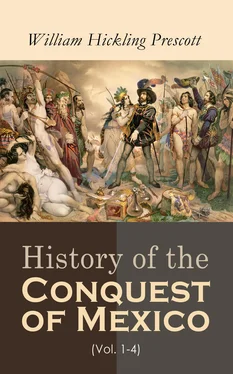But for this work he felt that the most careful preparation was necessary. In a letter, written eighteen months before his death, he says, “I proposed to devote ten years of my life to the study of ancient and modern literature, chiefly the latter, and to give ten years more to some historical work. I have had the good fortune to accomplish this design pretty nearly within the limits assigned. In the Christmas of 1837 my first work was given to the public.”
During the first ten years of preparation he was a frequent contributor to the Reviews, writing some of the papers which are printed in the volume of “Miscellanies” which has always formed part of his “works.” His historical work was accomplished with the utmost difficulty. American scholarship was not then advanced, and it was almost impossible to secure readers who possessed a knowledge of foreign languages. Pathetically Mr. Prescott tells of the difficulties surmounted. The secretary he employed at first knew no language but his own. “I taught him to pronounce the Castilian in a manner suited, I suspect, much more to my ear than to that of a Spaniard; and we began our wearisome journey through Mariana’s noble history. I cannot even now recall to mind without a smile the tedious hours in which, seated under some old trees in my country residence, we pursued our slow and melancholy way over pages which afforded no glimmering of light to him, and from which the light came dimly struggling to me through a half intelligible vocabulary. But in a few weeks the light became stronger, and I was cheered by the consciousness of my own improvement; and when we had toiled our way through seven quartos I found I could understand the book when read about two-thirds as fast as ordinary English.” Having thus gathered the ideas of his many authorities from the mechanical lips of his secretary, Mr. Prescott would ponder them for a time, and would then dictate the notes for a chapter of from forty to fifty pages. These notes were read and reread to him while the subject was still fresh in his memory. He ran them over many times in his mind before he began to dictate the final copy, and was thus able to escape errors into which men with full command of their sight frequently fall. For the last thirty years of his life he made use of a writing instrument for the blind, the noctograph, by which he was able to write his own pages and partially to dispense with dictation. With the noctograph he wrote with great rapidity, but in an almost illegible hand which only the author and his secretary could read.
When, after twenty years of labor, the “History of the Reign of Ferdinand and Isabella” was finished, its author was so doubtful respecting its value that he proposed simply to put it upon his library shelf “for the benefit of those who should come after.” His father wisely combated this morbid judgment and insisted upon its publication. “The man who writes a book which he is afraid to publish is a coward,” he said to his son. The work was given to the world in 1837 and was immediately and immensely successful. Its author, who had hitherto been only an obscure writer of reviews, took his place at once in the first rank of contemporary historians,—to use the words of Daniel Webster,—“like a comet that had blazed out upon the world in full splendor.” In a very short space of time translations appeared in Spanish, German, French, and Italian. Critics of many nationalities joined in concurrent praise.
In a way Mr. Prescott’s achievement was a national triumph. British reviewers were even more laudatory than were the American. One of the most striking testimonials came from Richard Ford, the author of the famous “Handbook for Spain,”—an English scholar whose knowledge of things Spanish was phenomenal. Mr. Ford wrote, “Mr. Prescott’s is by far the first historical work which British America has yet produced, and one that need hardly fear a comparison with any that has issued from the European press since this century began.” Mr. Ford was not enthusiastic over American institutions and was by no means prepared to believe that the American experiment in democratic government was likely to result in a permanent State. It was with an eye to posterity, therefore, that he cautiously and vaguely assigned Mr. Prescott not to the United States, but to British America. The commendatory notices that appeared in British publications showed that many men besides Mr. Ford were astounded that “British America” could produce such an excellent specimen of historical workmanship. Sydney Smith’s praise was most enthusiastic. He even went so far as to promise the American author a “Caspian Sea of Soup” if he would visit England.
The new historian was not spoiled by the adulation showered upon him. Rejoicing in the unexpected praise, he devoted himself with renewed zeal, and with even greater care, to the composition of another work. This, “The History of the Conquest of Mexico,” appeared in 1843, and in less than twelve months seven thousand copies of it had been sold in the United States. The art of advertising, in which the publishers of to-day are so proficient, had not then been developed; the “Conquest of Mexico” made its own way among the reading public. For the English copyright Bentley, the London publisher, paid £650. Ten editions were published in England in sixteen years, and twenty-three were issued in the United States. Popular approval was even more pronounced than in the case of the “Ferdinand and Isabella,” and the applause of the reviewers was also much more loud. The pure and sound English appealed especially to scholars like Milman. That famous historian placed Prescott “in the midst of the small community of really good English writers of history in modern times.” Coming from the editor of the best edition of Gibbon’s “Decline and Fall of the Roman Empire,” this was praise indeed. The Edinburgh Review said, “Every reader of intelligence forgets the beauty of his coloring in the grandeur of his outline.... Nothing but a connected sketch of the latter can do justice to the highest charm of the work.” Stirling, author of the “Cloister Life of the Emperor Charles the Fifth,” wrote, “The account of the Triste Noche, the woeful night in which, after the death of Montezuma, Cortés and his band retreated across the lake and over the broken causeway, cutting their way through a nation in arms, is one of the finest pictures of modern historical painting.” The Spanish Royal Academy of History had elected Prescott to membership in that august body soon after his “History of the Reign of Ferdinand and Isabella” appeared; other historical societies and learned bodies now heaped honors upon him.
The historian kept steadily at work. The task to which he had devoted himself was to tell the tale of Spanish greatness when the fortunes of Spain were at their highest point. The “History of the Conquest of Peru” was published in 1847, four years after the appearance of the “Mexico.” It reads like a romance and has always been the most popular of Prescott’s works. To-day it is the only history of the early Spanish achievements in Peru which is regarded as an “authority” on the South American republic, and is always kept in stock in Peruvian bookstores. For the English copyright of this work Bentley paid £800. Seventeen thousand copies were sold in thirteen years. The demand for it is constant.
The author’s fame was now fully established. He was everywhere regarded as one of the greatest of living historians, and honors and wealth flowed steadily towards him. His income from his books was very large. Stirling estimates it at from £4000 to £5000 per annum. This, in addition to the fortune he had inherited, made Mr. Prescott a very wealthy man in the years when the enormous incomes of to-day were hardly dreamed of. He was as methodical and careful in pecuniary affairs as in his literary work. A most accurate account was kept of his receipts and expenditures, and one-tenth of his income was always devoted to charity.
Читать дальше












